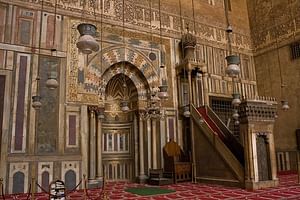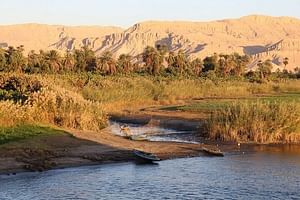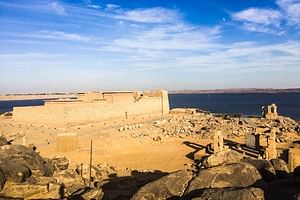Embark on an unforgettable 2-day adventure to Luxor from Hurghada, where you’ll have the opportunity to discover the treasures of this ancient city. Explore both the east and west banks of the Nile, visiting the awe-inspiring Valley of the Kings, the majestic temple of Queen Hatshepsut, and the towering Colossi of Memnon. As the day concludes, spend a magical evening in Luxor, embraced by the grandeur of the Nile.
On the second day, immerse yourself in the timeless beauty of Karnak and Luxor temples before making the scenic drive back to Hurghada, carrying with you the memories of Egypt’s remarkable history.
Duration
The tour starts at
-
Day 1
Luxor -West bank
Luxor -West bank
-
Day 1
At the beginning of your tour, you will cross the Nile to the West bank where you will visit the Valley of the Kings. The Pharaohs were hiding their mummies and treasures in this barren desert area. M...
At the beginning of your tour, you will cross the Nile to the West bank where you will visit the Valley of the Kings. The Pharaohs were hiding their mummies and treasures in this barren desert area. Many of these treasures were found in these beautiful colored tombs. You can visit three tombs to enjoy the colors and murals on the walls. The tombs were carved deep in the mountain rock; you have the option to visit other royal tombs such as Tut Ankh Amun
-
Day 1
Then continue your tour on the west bank and drive to the mortuary temple of Queen Hatshepsut. She is the first female pharaoh in ancient Egypt who ruled the kingdom for 20 prosperous years. This temp...
Then continue your tour on the west bank and drive to the mortuary temple of Queen Hatshepsut. She is the first female pharaoh in ancient Egypt who ruled the kingdom for 20 prosperous years. This temple is called El Deir el Bahari as the early Christians used the Northern monastery, as it was a Coptic monastery. Unlike the other temples, this one was built of limestone and partly hewn in the mother bedrock. It has three terraces and its focal point is to tell the story of the Divine birth of the Queen.
-
Day 1
The final stop will be at the colossi of Memnon. The Colossi of Memnon are two monumental statues representing king Amenhotep III of the 18th Dynasty of Egypt. They are located west of the modern city...
The final stop will be at the colossi of Memnon. The Colossi of Memnon are two monumental statues representing king Amenhotep III of the 18th Dynasty of Egypt. They are located west of the modern city of Luxor and face east looking toward the Nile River. The statues depict the seated king on a throne with some other carvings of his mother, his wife, the god Hapi, the Nile god, and other symbolic engravings. Both are carved from single blocks of sandstone and the name refers to the Greek hero Memnon who fell in the Trojan War
-
Day 1
5 star hotel in Luxor
5 star hotel in Luxor
-
Day 2
Luxor -East bank
Luxor -East bank
-
Day 2
After breakfast, the tour begins with the Karnak temple, which is a complex of temples. The temple is dedicated to Amun Ra, the chief god in Egyptian mythology. Enjoy the Great Hypostyle court and the...
After breakfast, the tour begins with the Karnak temple, which is a complex of temples. The temple is dedicated to Amun Ra, the chief god in Egyptian mythology. Enjoy the Great Hypostyle court and the reliefs and murals that were added through the generations. Feel astonished at the tall obelisks 70 feet high and cut from a single piece of granite. Look at the statues of the different pharaohs who want to show their loyalty to Ra. Keep an eye on the magnificent tall columns and their papyrus and Lotus capitals while their shafts are loaded with hieroglyphics.
-
Day 2
Originally Luxor temple and Karnak were connected with the Ram-Headed Sphinxes Avenue. The connection was to celebrate the annual visit of Ra from Karnak to his wife Mut in Luxor. The temple of Luxor ...
Originally Luxor temple and Karnak were connected with the Ram-Headed Sphinxes Avenue. The connection was to celebrate the annual visit of Ra from Karnak to his wife Mut in Luxor. The temple of Luxor witnessed many historical eras and has its extensions and additions along the ages. Different structures and murals show the Greek, Roman, Islamic, and Coptic influences.
Stare at the statues and obelisks of Ramses II. There should be two obelisks at the entrance of the temple but one of them was sent to Paris
Breakfast
Lunch
Qualified Egyptologist guide
Hotel pickup and drop-off from Hurghada
Transport by private vehicle
Overnight accommodation
Any personal expenses
Gratuities
Entrance fees to the tomb of Tut Ankh Amun












